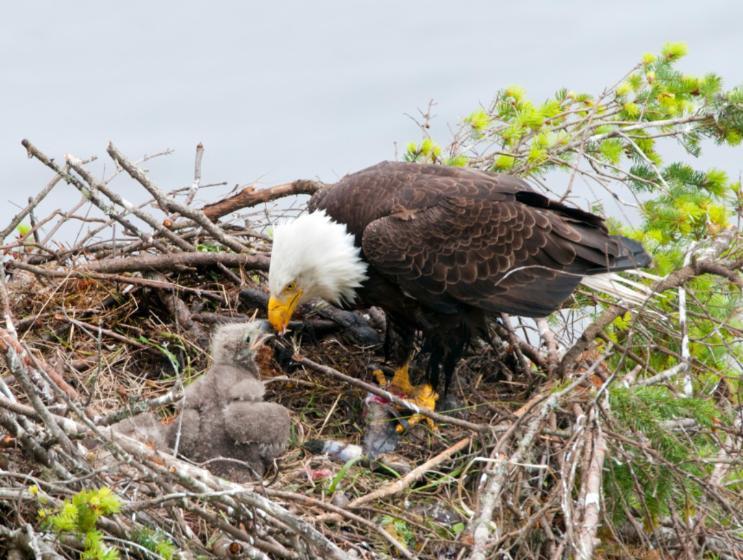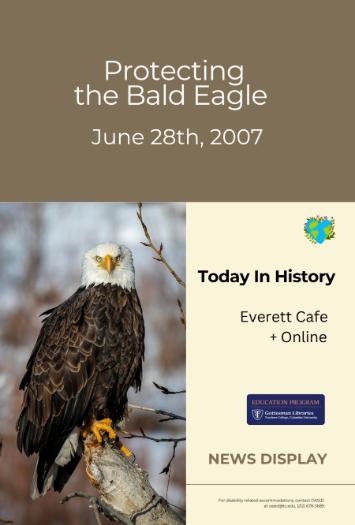Today In History: Protecting the Bald Eagle

Given time--time not in years but in millennia--life adjusts, and a balance has been reached. For time is the essential ingredient; but in the modern worl there is no time.
-- Rachel Carson, Silent Spring, p.6.
In the 1960s use of the synthetic insecticide DDT began to diminish after awareness was raised by the publication of Rachel Carson's influential book Silent Spring; Carson, a marine biologist, conservationist and writer, revealed the devastating results of DDT to bird populations, including the bald eagle. Ingesting DDT via mosquitoes flees, and other insects, caused birds to lay thin shelled eggs, easily and prematurely broken in nests. Fewer eggs meant fewer eagles -- rendering the species in danger of extinction.
By 1972 DDT was banned in the United States, and other countries followed suit. Groups and organizations such as the Environmental Defense Fund pushed for federal legislation to protect endangered species -- leading to the Endangered Species Act of 1973. From 487 nesting pairs of eagles in the 1960s, to more than 11,000 in 2007, came success in protecting the livelihood and future of our emblematic bird. On June 28th, 2007, the bald eagle was no longer deemed at risk. A technical update in 2020 from the U.S. Fish and Wildlife Service provided the latest estimates for the bald eagle population in the lower 48 states -- totaling 316,700 individuals and including 71,467 occupied nests.
The following articles are drawn from Proquest Historical Newspapers, which informs and inspires classroom teaching and learning.
- Total DDT Ban Meeting Opposition. (1999/08/29/, 1999 Aug 29). Chicago Tribune (1997-)
- Davenport, C. (2006/12/17/, 2006 Dec 17). Rescued Bald Eagle Part of Educational Program. The Washington Post (1974-)
- Barringer, F. (2007/02/08/, 2007 Feb 08). Interior Dept. Gets Reprieve on Its Decision on Bald Eagle. New York Times (1923-)
- Marshall, L. (2007/02/25/, 2007 Feb 25). Bald Eagle Gathering: A Testament to Bird's Recovery in Lower 48: Hundreds Flock to Wash. State for Salmon Feast. The Washington Post (1974-)
- Clayton, M. (2007/06/28/, 2007 Jun 28). Bald Eagle Is Set to Lose 'Threatened' Tag: Protected Since 1967 under the Endangered Species Act, the Eagle May Be Delisted as Soon as Today. The Christian Science Monitor (1908-)
- Fahrenthold, D. A. (2007/06/29/, 2007 Jun 29). U.S. Declares Bald Eagles No Longer Threatened. The Washington Post (1974-)
- Legal Eagle: The Eagle Has Landed. Will Other Species? (2007/07/01/, 2007 Jul 01). The Washington Post (1974-)
- Kunkle, F. (2007/07/15/, 2007 Jul 15). Homing in on the Bald Eagle: Just a Short Drive Off Busy Roads, Mason Neck Is a Showcase for the Majestic Bird. The Washington Post (1974-)
- Carswell, S. (2015/11/28/, 2015 Nov 28). Sorry Mr. Franklin, But the Bald Eagle Would Gobble the Competition: America Letter Up Close, the US's National Bird Shows Why It Is a Symbol of Strength. The Irish Times (1921-)
- Plumer, B., & Schwartz, J. (2020/04/22/, 2020 Apr 22). What's Better, What's Worse. New York Times (1923-)

- Bald Eagle, from CornellLab of Ornithology, (offers an overview, ID information, life history, maps, and sounds)
- Bald Eagles / [revised and edited by John Mathisen]. (1993). Lake States Interpretive Association, [1993?]. e-book
- Carson, R. (1962). Silent Spring. Houghton Mifflin. Stacks ; SB959 .C3 1962
- Gibbons, G. (1998). Soaring with the Wind : The Bald Eagle. Morrow Junior Books. Curriculum ; QL696.F32 G5 1998
- Lebbin, D. J. (Daniel J., Parr, M., & Fenwick, G. H. (2010). The American Bird Conservancy Guide to Bird Conservation. University of Chicago Press. e-book
- Pacific Bald Eagle Recovery Plan. (1986). U.S. Fish and Wildlife Service. e-book
- Patent, D. H., & Muñoz, W. (2000). The Bald Eagle Returns. Clarion Books. Curriculum ; QL696.F32 P35 2000
Images:
- Bald Eagle and Eaglet, Courtesy of Canva
- Bald Eagle Perched on a Tree, Courtesy of Canva
Need to keep current, look to the past, teach a topic? The Everett Cafe features daily postings of news from around the world, and also promotes awareness of historical events from an educational context. Be sure to check additional Cafe News postings on the library blog.


